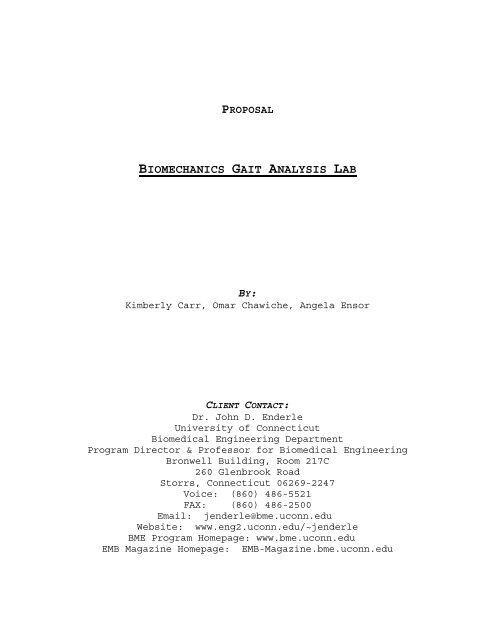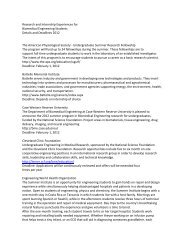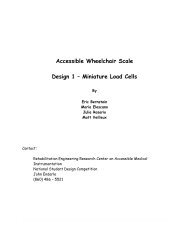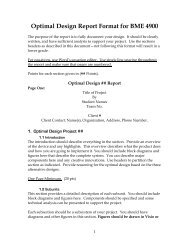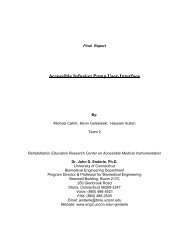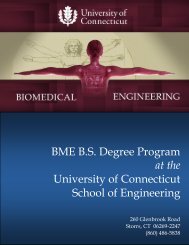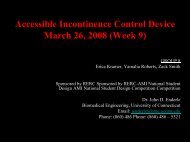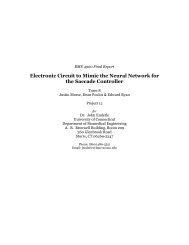proposal biomechanics gait analysis lab - Biomedical Engineering ...
proposal biomechanics gait analysis lab - Biomedical Engineering ...
proposal biomechanics gait analysis lab - Biomedical Engineering ...
You also want an ePaper? Increase the reach of your titles
YUMPU automatically turns print PDFs into web optimized ePapers that Google loves.
PROPOSAL<br />
BIOMECHANICS GAIT ANALYSIS LAB<br />
BY:<br />
Kimberly Carr, Omar Chawiche, Angela Ensor<br />
CLIENT CONTACT:<br />
Dr. John D. Enderle<br />
University of Connecticut<br />
<strong>Biomedical</strong> <strong>Engineering</strong> Department<br />
Program Director & Professor for <strong>Biomedical</strong> <strong>Engineering</strong><br />
Bronwell Building, Room 217C<br />
260 Glenbrook Road<br />
Storrs, Connecticut 06269-2247<br />
Voice: (860) 486-5521<br />
FAX: (860) 486-2500<br />
Email: jenderle@bme.uconn.edu<br />
Website: www.eng2.uconn.edu/~jenderle<br />
BME Program Homepage: www.bme.uconn.edu<br />
EMB Magazine Homepage: EMB-Magazine.bme.uconn.edu<br />
1
TABLE OF CONTENTS<br />
Section Page Number<br />
1. Introduction 1 – 6<br />
1.1 Background 1<br />
1.2 Project Purpose 1<br />
1.3 Previous Work Done by Others 1 - 4<br />
1.3.1 Products 5<br />
1.3.2 Patent Search Results 6<br />
2. Project Description 7 – 14<br />
2.1 Objective 8 – 9<br />
2.2 Methods 9 – 13<br />
3. Budget 14<br />
4. Conclusion 15 - 16
1. Introduction<br />
1.1 Background<br />
Dr. John D. Enderle is the Editor-in-Chief of the EMB Magazine,<br />
<strong>Biomedical</strong> <strong>Engineering</strong> Book Series Editor for Morgan and<br />
Claypool Publishers, and the Program Director & Professor for<br />
<strong>Biomedical</strong> <strong>Engineering</strong> at the University of Connecticut. Dr.<br />
Enderle has been looking to improve the <strong>gait</strong> <strong>analysis</strong> <strong>lab</strong> for<br />
the undergraduate <strong>Biomedical</strong> <strong>Engineering</strong> program’s Biomechanics<br />
<strong>lab</strong>oratory. Currently, the <strong>biomechanics</strong> <strong>gait</strong> <strong>analysis</strong> <strong>lab</strong><br />
essentially consists of the students participating in the<br />
process of acquiring data through software applications in the<br />
forward motion only, which limits the students to only obtain or<br />
calculate measurements of distance, acceleration, speed, angles,<br />
and joint moments using the assumption that the ground reaction<br />
forces exerted is simply the subject’s weight. The missing<br />
component to the <strong>gait</strong> <strong>analysis</strong> is a true-life measure of ground<br />
reaction forces exerted on the foot strike, which are applied in<br />
multiple directions.<br />
1.2 Project Purpose<br />
Dr. Enderle has requested an expansion of the <strong>gait</strong> <strong>analysis</strong> <strong>lab</strong><br />
by utilizing a force measurement system. This improvement will<br />
afford students the opportunity to obtain an accurate<br />
measurement of the affects of motion in more than one direction.<br />
The new system will record and provide data on the affects of<br />
foot strike. The addition of a force measurement system will<br />
add value to the <strong>lab</strong> and the <strong>Biomedical</strong> <strong>Engineering</strong> program by<br />
allowing for a more “real world” <strong>biomechanics</strong> <strong>lab</strong>oratory<br />
experience. Many <strong>gait</strong> <strong>analysis</strong> <strong>lab</strong>oratories across the world<br />
have a force measurement system, along with a motion recording<br />
system.<br />
1.3 Previous Work Done by Others<br />
There are three categories for the collection of <strong>gait</strong> <strong>analysis</strong><br />
data that will be considered in this section; foot pressure,<br />
force plates, and motion systems. The acquired data from these<br />
devices or systems are sent to a computer software program, of<br />
which the type of program is dependent upon the types of <strong>gait</strong><br />
<strong>analysis</strong> devices used and the desired program features, to<br />
synthesize and display the results. Two of the foot pressure<br />
options consist of pressure mats and insoles. The force exerted<br />
on the ground can be collected by force plates and the motion<br />
Page 1
systems include electromyography (EMG) and a video motion<br />
system.<br />
Foot Pressure<br />
Tekscan, Inc., located in South Boston, MA, has designed and<br />
manufactured many <strong>gait</strong> <strong>analysis</strong> products, including a few models<br />
of pressure insoles and mats. (1c)Pressure insoles can be used,<br />
in a clinical setting, for evaluating patients before and after<br />
surgery, screen for neuropathic disorders such as diabetes, and<br />
measure any length discrepancies in lower limbs, which could<br />
potentially be useful in assessing patients prior to hip<br />
replacement surgery for determining implant specifications. The<br />
insoles work much the same as pressure mats, which consist of<br />
capacitive or force sensitive resistor (FSR) switches placed in<br />
between two pieces of material that is either placed on the<br />
floor as a mat or on the inside or outside of a shoe.<br />
Compression closing switches have two sheets of brass shim rock,<br />
(1b) a thin sheet of brass that has been cold rolled, with a<br />
compressible, non-conductive foam rubber insole, which has holes<br />
containing conductive rubber cylinders, in between the shim<br />
rock. The conductive rubber cylinders make contact with both<br />
sheets of sham rock and close an electric circuit upon<br />
application of pressure. Force sensitive resistor (FSR)<br />
switches have a similar sandwich approach that uses flexible<br />
plastic for the outer layers, with circuits printed on the<br />
inside of the two plastic sheets. In between the plastic<br />
sheets, there is a slender layer of double-sided adhesive, with<br />
holes that allow for areas of contact. Similar to the<br />
compression closing switch, pressure causes the electric circuit<br />
to close, except this device has a resistive electric circuit,<br />
so that when pressure is increased, the resistance decreases.<br />
Force Plate Device<br />
Several models of force plates have been designed and produced<br />
by Bertec Corporation, based in Columbus, OH, Advanced Medical<br />
Technology, Inc., based in Watertown, MA, and Kistler<br />
Instrumente AG, based in Winterthur, Switzerland. Ground<br />
reaction forces can be measured by using a force plate. These<br />
devices include a top plate and a bottom plate or frame, which<br />
are separated by force transducers attached to each corner of<br />
the rectangular or square plates. The entire device is<br />
installed into a platform so that the top plate is flush with<br />
the surface of the platform to prevent changes in a subject’s<br />
<strong>gait</strong>. As the subject walks along the platform and strikes the<br />
Page 2
top plate, the exerted force is transferred to the transducers.<br />
There are two types of force plates called piezoelectric and<br />
strain gauge. The piezoelectric force plate uses quartz<br />
transducers that create an electric charge when force is exerted<br />
on the top plate. The strain gauge force plates have load cells<br />
that measure stress when a force is exerted on the top plate.<br />
In both types, the devices provide vertical and shear forces, as<br />
well as the (1a)“center of pressure” during <strong>gait</strong>.<br />
Motion Systems<br />
Electromyography (EMG) utilizes electrogoniometers that are<br />
attached to the proximal and distal ends of the limb segments<br />
that are to be evaluated. One manufacturer of electrogoniometer<br />
is Biometrics Ltd., located in the United Kingdom and the United<br />
States, and another is Noraxon, located in the United States and<br />
Germany. These devices are electro-mechanical devices that (1a)<br />
“provide an output voltage proportional to the angular change<br />
between the two attachment surfaces.” This system for motion<br />
<strong>analysis</strong> makes the assumption that the devices move in sync with<br />
the midline of the segment being measured and therefore, give an<br />
accurate representation of the angular change at the joints of<br />
the segments under consideration. The disadvantage is the<br />
tracking (or in sync motion with the midline) is affected when<br />
the person is not a lean individual, so that any type of bulkyness<br />
will affect the accuracy of the results due to skin or<br />
muscle movement.<br />
ViconPeak is a manufacturer and supplier of motion systems and<br />
is based in the United Kingdom, with two locations in the United<br />
States. Video motion systems, also referred to as<br />
optoelectronic systems or stereophotogrammetry, use one or more<br />
digital video cameras that track markers placed on the body of a<br />
subject. The types of markers used include infrared (IR) lightemitting<br />
diodes (LEDs) and reflective markers. The infrared<br />
(IR) light-emitting diodes (LEDs)require the use of a battery,<br />
circuits, and cables that can be cumbersome to use, but<br />
alleviate the issue of a camera losing sight of the marker. The<br />
reflective markers are much simpler to use and can be just as<br />
effective, even under the restraints of the user maintaining<br />
marker visibility by the camera.<br />
Complete Analysis<br />
The foot pressure devices and the force plate device can be used<br />
in conjunction with the motion systems to offer a more<br />
comprehensive <strong>analysis</strong> of <strong>gait</strong>, which is the focus of this <strong>gait</strong><br />
Page 3
<strong>analysis</strong> project, and are used clinically. There a numerous<br />
<strong>lab</strong>oratories that utilize <strong>gait</strong> <strong>analysis</strong>, some examples include<br />
the Derby Gait and Movement Laboratory (www.<strong>gait</strong>.com), the Hugh<br />
Williamson Gait Analysis Laboratory<br />
(www.rch.org.au/<strong>gait</strong>/index.cfm?doc_id=1595) as part of the Royal<br />
Children’s Hospital in Melbourne, Australia, and the Shriner’s<br />
Hospital for Children. One company that provides entire <strong>gait</strong><br />
<strong>analysis</strong> systems is Ariel Dynamics, at www.arielnet.com.<br />
1.3.1 Products<br />
Tekscan, Inc. Products for Foot Pressure Devices:<br />
F-Scan ® System<br />
Bipedal In-Shoe Plantar<br />
Pressure/Force Measurement<br />
www.tekscan.com<br />
Walkway TM System<br />
Floor Mat-based Pressure/Force Measurement<br />
www.tekscan.com<br />
Bertec Corporation Products for Force<br />
Plates:<br />
4060 Force Plate Series<br />
www.bertec.com<br />
Dimensions in mm(342A X 552B X 29C X 24D)<br />
4060-08 model is made of solid aluminum<br />
4060-NC Force Plate Series<br />
Dimensions in mm(342A X 552B X 29C X 24D)<br />
Non-conductive and made of resin<br />
impregnated wood.<br />
www.bertec.com<br />
Page 4
NorAngle Electrogoniometer System (for<br />
Electromyography EMG)<br />
www.noraxon.com<br />
ViconPeak High Speed Video Camera<br />
Model HSC-200 PM<br />
www.vicon.com<br />
1.3.2 Patent Search Results<br />
Searching for United States patents prior to undertaking an<br />
engineering project or design is obligatory. A patent restricts<br />
the use of any part of a patented invention, in that, another<br />
company or person cannot make, use, or sell the invention in the<br />
United States for a period of time that depends on the type of<br />
invention. For a design patent, the term period is 14 years<br />
from the grant date of the patent.<br />
A quick search through the US Patent database of patents since<br />
1975 can be done at www.uspto.gov/patft/index.html. Using the<br />
term ‘<strong>gait</strong> <strong>analysis</strong>’ in the quick search brought up 110 filed<br />
patents with that term in the text of the patent form. Some of<br />
the patents include:<br />
6,997,882 6-DOF subject-monitoring device and method – February<br />
14, 2006 – Parker, et al.<br />
This patent covers an invention that includes methods and<br />
devices for monitoring and acquiring specific data from a<br />
subject’s movement and physiological measurements, which, in<br />
part, involves the use of an accelerometer.<br />
6,836,744 Portable system for analyzing human <strong>gait</strong> – December<br />
28, 2004 – Asphahani, et al.<br />
The patent describes an invention for a portable <strong>gait</strong> analyzer<br />
which uses a type of pressure insole with detachable parts.<br />
5,408,873 Foot force sensor – April 25, 1995 – Schmidt, et al.<br />
Page 5
This patent is for another type of pressure insole that consists<br />
of outer layers that are conductive and an inner layer that is<br />
nonconductive.<br />
4,631,676 Computerized video <strong>gait</strong> and motion <strong>analysis</strong> system and<br />
method – December 23, 1986 – Pugh; James W.<br />
This patent describes a computerized video <strong>gait</strong> and motion<br />
<strong>analysis</strong> system and method that use reflective markers, Sony<br />
Video Motion Analyzers, video recorders and displays, and<br />
computer system for displaying the results obtained from the<br />
data.<br />
2. Project Description<br />
2.1 Objective<br />
The objective of the project is to design a <strong>gait</strong> <strong>analysis</strong> <strong>lab</strong><br />
for a <strong>biomechanics</strong> class, so that students may learn about <strong>gait</strong><br />
<strong>analysis</strong> and how the data is analyzed through computer software<br />
applications. In general, <strong>gait</strong> <strong>analysis</strong> is used to provide<br />
objective measurements concerning a person’s movement patterns.<br />
The set-up will utilize the LabVIEW® software program to analyze<br />
analog data, and hardware parts such as a force measurement<br />
device to measure the forces and moments generated during<br />
footfall. In addition, National Instruments equipment, which is<br />
already avai<strong>lab</strong>le in the <strong>lab</strong>, will be used for the purpose of<br />
image acquisition and a digital camera to record the <strong>gait</strong> cycle.<br />
To record the <strong>gait</strong> cycle using the digital camera, external<br />
markers are placed laterally on the hip, knee, and ankle of the<br />
right or left leg depending on the camera set up, which reflect<br />
light to the camera and allow the segment of motion to be<br />
monitored. To properly set up the force measurement device in<br />
the <strong>biomechanics</strong> <strong>lab</strong>oratory, it must be placed so that the<br />
person can complete one full <strong>gait</strong> cycle and step on the<br />
measuring device, with the digital camera placed so that it will<br />
receive the reflected light from the markers. The camera should<br />
be connected to the National Instrument PXI-1031 which contains<br />
the National Instrument 1411 series, consisting of PCI and PXI<br />
plug-in image acquisition cards that receive analog signals from<br />
a standard color or monochrome camera. The BNC-2100 series<br />
connector block is added to the set-up for ease of connectivity<br />
and control of the analog input, analog output, and digital I/O.<br />
Page 6
In the <strong>lab</strong>oratory, the students will connect the digital<br />
recorder camera to the National Instrument PXI-1031 device,<br />
followed by connection to the BNC-2100 series connector block,<br />
to regulate the process, and connect BNC-2100 to the computer.<br />
Additionally, students may be required to build a portion of the<br />
LabVIEW® software program to analyze the data. Students will<br />
then place the markers on the different segments of the<br />
subject’s leg. The subject will walk towards the force<br />
measurement device, stepping on the device during the cycle,<br />
while the digital camera records the action. Throughout the<br />
entire process, the National Instrument devices and LabVIEW®<br />
program transform the digital data into analog data, which can<br />
be used to determine distance, speed, acceleration, angles, and<br />
forces acting on the body. The results will provide information<br />
that characterizes an individual’s foot strike pattern.<br />
In the end, the students will learn how the LabVIEW® program<br />
operates, how to set up a <strong>lab</strong>oratory environment, and how the<br />
entire set-up aggregates the information gathered to give<br />
meaningful results.<br />
2.2 Methods<br />
The Clinical Gait Model and Kinematic Data Analysis<br />
The clinical <strong>gait</strong> model is an algorithm that connects the data<br />
which is collected during the subject’s walking cycles to the<br />
information necessary for scientific <strong>analysis</strong>. For kinematic<br />
data <strong>analysis</strong>, three noncolinear reference points or markers are<br />
placed on a subject’s body segment to permit the tracking of the<br />
spatial orientation of that segment through space. From these<br />
reference points, a plane is formed which allows the derivation<br />
of a segmentally fixed coordinate system for the subject. In<br />
order to accurately quantify the subject’s kinematics, markers<br />
have to be referenced to their anatomy and placed either<br />
directly over apparent bony regions on the segment or at<br />
convenient positions along the segment which are visible to the<br />
measurement camera(s) being utilized. For example, markers<br />
placed over the right and left anterior-superior-iliac-spine<br />
(ASIS) and either the right or left posterior-superior-iliacspine<br />
(PSIS), for the pelvis, will allow for the calculation of<br />
an anatomically oriented segmental coordinate system (Figure 1).<br />
Page 7
Figure 1. Kinematic markers<br />
used to define pelvis and thigh<br />
coordinate systems. For the<br />
pelvis, PSIS denotes posteriorsuperior-iliac-spine,<br />
H is hip<br />
center, and RASIS and LASIS<br />
denote right and left anteriorsuperior-iliac-spine<br />
markers,<br />
respectively. For the thigh,<br />
TW is thigh wand, K is knee<br />
center, and MK and LK are<br />
medial and lateral knee<br />
(femoral condyle) markers,<br />
respectively.<br />
Kinematic data can also be combined with ground reaction data<br />
such as forces, torque, and their points of application also<br />
referred to as the centers of pressure. Also, the net joint<br />
reactions including joint forces and moments can be computed by<br />
combining the ground reactions with estimates of segment mass<br />
and mass moments of inertia. Consider the following patient<br />
with a mass of 25.2 kg to demonstrate the calculation of the<br />
reactions at the ankle (Figure 2); data for one instant in the<br />
<strong>gait</strong> cycle are as follows (2a):<br />
Page 8
Force Plates<br />
Figure 2. Ankle A and toe T<br />
marker data are combined with<br />
ground reaction force data Fg<br />
and segment mass and mass<br />
moment of inertia estimates to<br />
compute the net joint forces<br />
and moments.<br />
A force plate is a device that measures the ground reaction<br />
forces exerted by a subject as they step on it during <strong>gait</strong>.<br />
Force plates consist of a top plate, which is mounted level with<br />
the surrounding floor (platform), separated from the bottom<br />
frame by force transducers at each corner; the forces exerted on<br />
the top surface are transmitted through the force transducers.<br />
Force plates allocate the measurement of both the vertical and<br />
shear forces, as well as the center of pressure for the subject<br />
throughout <strong>gait</strong>. At the moment, there are two types of force<br />
plates commercially avai<strong>lab</strong>le: piezoelectric and strain gauge.<br />
The type of force plate employed does not necessarily make a<br />
significant difference for clinical <strong>gait</strong> applications.<br />
Piezoelectric force plates (PEFPs) utilize quartz transducers<br />
that produce an electric charge when stressed. These PEFPs do<br />
not require a power supply, but do however, require special<br />
charge amplifiers and low noise coaxial cables in order to<br />
convert the charge to a voltage proportional to the applied<br />
load. Strain gauge force plates (SGFPs) on the other hand, use<br />
strain gauges to measure the stress in specially machined<br />
aluminum transducer bodies referred to as load cells, when a<br />
subject’s load is applied. Unlike the PEFPs, the SGFPs do not<br />
require special cabling or charge amplifiers, but do require<br />
excitation of the strain gauge bridge circuit. Generally, the<br />
PEFPs are more sensitive and have a greater force range than the<br />
SGFPs.<br />
Page 9
Pressure Mats<br />
A pressure mat is a quick and easy way of obtaining a plantar<br />
pressure picture of a subject as they walk on it during <strong>gait</strong>.<br />
Today, there are two types of transducers in use for plantar<br />
measurement: capacitive and force sensitive resistor (FSR). The<br />
capacitor transducers consist of two capacitor plates separated<br />
by a compressible rubber dielectric material. When a pressure<br />
is applied to the transducer, the capacitor plates are pushed<br />
closer together, resulting in a capacitance that is calibrated<br />
in units of pressure. The FSR transducers, on the other hand,<br />
consist of two thin layers of flexible plastic with printed<br />
circuits on the inner surfaces, separated by thin layer of<br />
double-sided adhesive. When a pressure is applied to the<br />
transducer, carbon on one surface contacts a metal pattern on<br />
the other surface, creating a resistive electrical circuit; as<br />
pressure is applied, the resistance drops. Since the<br />
transducers tend to be nonlinear, the precision of these systems<br />
relies on the ability to consistently calibrate them. Commonly,<br />
pneumatic pressure bladder calibration systems are used to<br />
calibrate the transducers, and because the area of the<br />
transducers is known, the applied force may be determined by<br />
summing the force computed from each active sensor for a<br />
particular instance. Pressure mats provide a valuable and quick<br />
way of revealing the areas of high pressure on the plantar<br />
surface of the foot. The following table (Table 1) compares<br />
three different pressure mat systems that are factory calibrated<br />
and provide software that includes color pressure pictures, <strong>gait</strong><br />
lines, force and pressure versus time, force and pressure/time<br />
integrals, and masks for detailed <strong>analysis</strong> of selected areas of<br />
the foot:<br />
Manufacturer<br />
Musgrave<br />
Systems<br />
Novel<br />
Electronics<br />
(EMED)<br />
Tekscan<br />
(F-Mat)<br />
Sensor<br />
Type<br />
Table 1: Pressure Mat Features<br />
Size (mm)<br />
No. of<br />
Sensors<br />
Sensor<br />
Density<br />
(per cm 2 )<br />
FSR 194 x 394 x 38 2,048 2.7 55.6<br />
Capacitive 225 x 445 x 6 2,016 2 70<br />
FSR 320 x 470 x 6 2,128 1.4 120<br />
Sample<br />
Rate (Hz) Calibration<br />
Dynamic<br />
Force<br />
Static<br />
Pressure<br />
Bladder<br />
Static Force<br />
Special<br />
features<br />
Double Plate<br />
System<br />
Avai<strong>lab</strong>le<br />
Podometry<br />
Software<br />
Provided<br />
Real Time<br />
Display<br />
Page 10
Gait Mats<br />
A <strong>gait</strong> mat is a fairly new system that presents both temporal<br />
and spatial <strong>gait</strong> considerations. Gait mats usually consist of<br />
an array of switches embedded along the entire length of a long<br />
strip of walking surface, like a carpet (Figure 3). As a<br />
subject walks along the mat, the switches close under the feet,<br />
allowing the computer to compute the timing of each switch<br />
closure. The spatial parameters of <strong>gait</strong> can be determined using<br />
the geometry of the mat. The major advantages of <strong>gait</strong> mats are<br />
the step length measurements, removal of any <strong>gait</strong> hindering<br />
attachments, relatively low cost, and portability.<br />
Unfortunately, some disadvantages to using the <strong>gait</strong> mat are the<br />
temporal resolution due to limitations in the scan rate and the<br />
spatial resolution due to the finite size of the switches. The<br />
following table (Table 2) compares two different <strong>gait</strong> mat<br />
systems that both provide an extensive database and have<br />
provisions for editing the raw data file:<br />
Manufacturer Type<br />
CIR Systems<br />
(GAITRite)<br />
EQ, Inc.<br />
(Gait Mat)<br />
Portable<br />
(1)<br />
Transportable<br />
(2)<br />
Active Area<br />
(cm)<br />
Table 2: Gait Mat Features<br />
Thickness<br />
(mm)<br />
Switch<br />
Spacing<br />
(mm)<br />
Temporal<br />
Resolution<br />
(msec)<br />
61 x 3.66 4 12.7 11<br />
61 x 4.17 32 15 10<br />
Special Features/<br />
Considerations<br />
Can handle walking aid<br />
patterns, Computes<br />
FAP score (3)<br />
Needs 32 mm thick<br />
runways at each end<br />
for pre & post walk<br />
area (4)<br />
(1) Can be rolled up and carried in a convenient plastic golf case; (2) Folds into four 99 × 41 × 1 cm pieces that fit in a storage case; (3) The<br />
Functional Ambulation Performance (FAP) score is a single numeric representation of a person's <strong>gait</strong>, based upon temporal and spatial <strong>gait</strong> data<br />
as well as the person's physical measurements; (4) Manufacturer does not provide runways.<br />
a b<br />
Figure 3. The GAITRite portable <strong>gait</strong> <strong>analysis</strong> system. a)<br />
demonstrates the portability of the mat and b) shows a subject<br />
walking along the mat.<br />
Page 11
Electrogoniometers<br />
An electrogoniometer is an electro-mechanical device that spans<br />
the desired measured joint from the proximal and distal body<br />
segments (Figure 4). Electrogoniometers supply an output<br />
voltage comparative to the angular change between the two<br />
attachment surfaces. These devices measure the actual angular<br />
change at the specified joint, under the assumption that the<br />
attachment surfaces move along with the midline of the body<br />
segment. There are two main advantages when using<br />
electrogoniometers for <strong>gait</strong> <strong>analysis</strong>, they are quite inexpensive<br />
and they are easy to operate. Unfortunately, a major<br />
disadvantage is that skin and muscle movement may cause<br />
inaccurate readings in the subject’s angular change.<br />
Figure 4. A Penny & Giles strain<br />
gauge electrogoniometer applied at<br />
the knee. The strain gauge in the<br />
small spring measures the angle<br />
between the plastic endblocks that<br />
are attached to the leg with<br />
double-sided adhesive tape.<br />
Optoelectronic Systems - Stereophotogrammetry<br />
One or more video cameras can be used in a video system in order<br />
to track the bright markers that are placed on the subject along<br />
specific locations. For a passive marker system, the markers<br />
are usually solid shapes covered with retroreflective tape.<br />
Furthermore, for an active marker system, the markers are<br />
generally infrared (IR) light-emitting diodes (LEDs). Both of<br />
these systems keep track of the horizontal and vertical<br />
coordinates from all of the markers from each camera. For a<br />
three-dimensional (3D) system, the computer software program<br />
calculates the 3D coordinates for each of the specified markers<br />
using the two-dimensional (2D) data obtained from two or more<br />
video cameras. When a single camera is used for <strong>gait</strong> <strong>analysis</strong>,<br />
one is assuming that all of the motion is occurring in a single<br />
plane that is perpendicular to the camera axis. This is rarely<br />
the case upon examining a subject’s <strong>gait</strong>, and as a result, 2D<br />
systems are not recommended for use in <strong>gait</strong> <strong>analysis</strong> (2b).<br />
Page 12
3. Budget<br />
The cost of building the project is considerable lower compared<br />
to projects that have no components already avai<strong>lab</strong>le and<br />
required to use. This is due to the fact that we already have<br />
much of the equipment that will be used to build the project,<br />
with the exception of the force measuring device. The only<br />
exception may come from the need to use more advance equipment<br />
to obtain accurate data or the current equipment is found to be<br />
incompatible with other components.<br />
The digital camera and tripod that is used for the current<br />
<strong>biomechanics</strong> <strong>lab</strong> set-up will be considered for use in the new<br />
<strong>lab</strong>. Additionally, the National Instrument equipment already in<br />
stock will be used in the new <strong>lab</strong> and was not previously used.<br />
These devices including the National Instruments PXI-1031 and<br />
the BNC-2100 series connector block.<br />
The LabVIEW® software program is already avai<strong>lab</strong>le on the<br />
computers in the <strong>biomechanics</strong> <strong>lab</strong> and in use for other<br />
<strong>Biomedical</strong> <strong>Engineering</strong> <strong>lab</strong>s as well, so this project will not<br />
require any additional purchase of software as the customer has<br />
requested the use of this product. A complete system bought<br />
through retailers starts at around $22,000.<br />
Item Retail<br />
Digital Camera(s) $350-$10,000 $0<br />
Camera Tripod(s) $275-$825 $0<br />
Est.<br />
Project<br />
Reflective Ball Markers (set of 30 passive) $300 $105<br />
Computer Software and Computer $2,500-$5,000 $0<br />
Force Measurement Device Components $200-$30,000 $150-$350<br />
Electrical Components $100-$500 $50-$150<br />
National Instruments PXI-1031 $1,000 $0<br />
National Instruments BNC-2100 $295 $0<br />
Miscellaneous $100 $145<br />
Total $5,120-$48,295 $405-$750<br />
Page 13
4. Conclusion<br />
The <strong>gait</strong> <strong>analysis</strong> <strong>lab</strong> is important for the Biomechanics class<br />
because the students are able to gain a deeper understanding of<br />
mechanical applications and how <strong>gait</strong> <strong>analysis</strong> is used<br />
clinically. Additionally, they will gain further crossfunctional<br />
engineering skills by creating the LabVIEW® software<br />
program necessary to run the <strong>lab</strong>. The goal of our project is to<br />
build a different <strong>gait</strong> <strong>analysis</strong> <strong>lab</strong> where the students can learn<br />
more about the entire set-up, while keeping the project within a<br />
reasonable budget compared to the cost of a commercially built<br />
<strong>lab</strong>.<br />
The design of our project is considered to be unique for two<br />
reasons. First it has an added feature that the current <strong>lab</strong><br />
does not, which will provide the students with more realistic<br />
results. Missing from the current <strong>lab</strong>, a force measurement<br />
device will be introduced that will require the students to<br />
determine what forces are applied on the plate and how the plate<br />
operates. The force measurement device will give accurate force<br />
measurements, which were previously assumed. Second, as part of<br />
the new <strong>lab</strong>, students will be able to gain more knowledge of<br />
<strong>gait</strong> <strong>analysis</strong> by learning how to use the software as well as the<br />
hardware aspects of the <strong>lab</strong>.<br />
Comparing the new <strong>lab</strong> with the original <strong>lab</strong>, where students<br />
usually collect the data and use a program to display the<br />
results, in the new <strong>lab</strong>, creation of the LabVIEW® software<br />
program will provide a more challenging and educational<br />
environment that allows the students to increase their knowledge<br />
of writing programs and applying the program to a real<br />
application. As with the current <strong>lab</strong>, motion devices will be<br />
used during the <strong>lab</strong>, so that the students learn how the images<br />
are captured and used to obtain useful results. Finally<br />
students will gain more knowledge about the hardware used<br />
through setting up the <strong>lab</strong> and connecting all of the devices and<br />
assuring that it works properly.<br />
In the market, the cost of a <strong>gait</strong> <strong>analysis</strong> <strong>lab</strong> with all the<br />
equipment needed starts at around twenty-two thousand United<br />
States dollars, whereas our project will provide a <strong>lab</strong> that<br />
should fall under 5 percent of market cost. Our most costly<br />
expense is expected to come from the plate measurement device,<br />
which will also be produced considerably less than market value.<br />
Page 14
Overall, this project will provide the added components that<br />
have been delayed due to the time constraints of Dr. Enderle’s<br />
growing department. The final results will provide all of the<br />
elements required to make a more robust and successful<br />
educational experience for the students.<br />
References and Bibliography for Section 1.3:<br />
(1a) Instrumented Gait Analysis Systems by Ernest L. Bontrager,<br />
MS.<br />
www.<strong>lab</strong>oratorium.dist.unige.it/~piero/Teaching/Gait/B<br />
NTRAER%20Instrumented%20Gait%20Analysis%20Systems.htm<br />
(1b) www.toolsandsupplies.com/shimstockinfo.htm<br />
(1c) Tekscan, Inc.<br />
www.tekscan.com<br />
www.<strong>lab</strong>oratorium.dist.unige.it/~piero/Teaching/Gait/BONTRAG<br />
ER%20Instrumented%20Gait%20Analysis%20Systems.htm, was used<br />
as a source for the information provided in this section,<br />
with direct quotes noted in the text and with the exception<br />
of reference to (1b).<br />
Mentioned companies can be found at:<br />
www.teckscan.com<br />
www.bertec.com<br />
www.amti.biz<br />
www.kistler.com<br />
www.biometricsltd.com<br />
www.vicon.com<br />
References and Bibliography for Section 2.2:<br />
(2a) Enderle, J. D.(2000). Introduction to <strong>Biomedical</strong><br />
<strong>Engineering</strong>. San Diego, CA. P. 451-457.<br />
(2b) Instrumented Gait Analysis Systems by Ernest L. Bontrager,<br />
MS.<br />
www.<strong>lab</strong>oratorium.dist.unige.it/~piero/Teaching/Gait/BO<br />
NTRAGER%20Instrumented%20Gait%20Analysis%20Systems.htm<br />
Page 15


